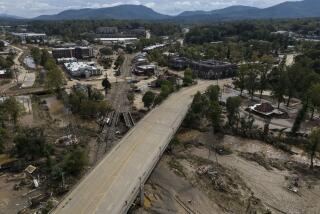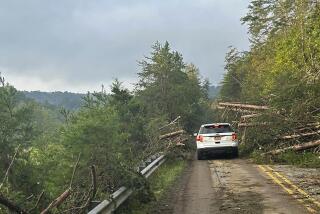Weakened Georges Aims for Florida
- Share via
MIAMI — As a ragged and weakened Hurricane Georges plowed westward across Cuba in the general direction of the United States, a state of emergency was declared for the entire southern tip of Florida on Wednesday in anticipation that high winds, torrential rains and flooding were imminent.
All 100,000 residents of the vulnerable Florida Keys were ordered to pack up and leave home. Hospitals in Key West and Marathon were evacuated, with some patients airlifted by military C-130s to hospitals in Central Florida. Gov. Lawton Chiles authorized the call-up of 2,800 National Guard troops.
In Miami and Fort Lauderdale, public schools and most private schools canceled classes scheduled for today and Friday, and many offices planned to close early. Many residents and merchants began to bolt on storm shutters, and supermarkets were crowded as shoppers stocked up on food and water.
As the eye of the storm moved over eastern Cuba and into the mountains, Georges was more of a rainmaker, no longer the fearsome system blamed for at least 110 deaths in Puerto Rico, the Dominican Republic, Haiti and the Leeward Islands. Dominican Republic President Leonel Fernandez said 70 people were killed in his country alone.
Forecasters at the National Hurricane Center in Miami feared that Georges could intensify as it moves over the warm waters of the Florida Straits.
“Satellite pictures make us think it is coming back like gangbusters,” said Jerry Jarrell, center director.
Hurricane warnings remained in effect for the southern and central Bahamas and the Turks and Caicos Islands, as well as for South Florida. Tropical storm warnings were issued for the Cayman Islands and Jamaica.
Big Slice of State Under Hurricane Watch
Uncertainty over the storm’s track led forecasters to issue a hurricane watch for nearly a third of the Florida peninsula, from Deerfield Beach on the Atlantic coast to Bonita Beach, near Fort Myers, on the Gulf of Mexico. Georges’ sustained winds, which fell to 75 mph as the storm passed over the mountainous interiors of Hispaniola and Cuba, were likely to increase, possibly to as great as 110 mph, before the hurricane begins to batter Florida sometime later today.
“Given half a chance, this storm may become stronger than we’re forecasting,” Jarrell said. “We think a Category 3 [with maximum sustained winds between 111 mph and 130 mph] will hold it. But I’m still not comfortable. “
The hurricane watch set off a frenzy of activity in South Florida, especially in such areas as Homestead, Florida City and southern Miami-Dade County, devastated by Hurricane Andrew in 1992. Georges is no Andrew, forecasters advised. But that did not assuage the fears of those terrified by Andrew’s 140-mph winds.
Six years ago Michael Cogan, a Miami dentist, huddled under a bunk bed with his son, Nash, then 9, and watched the roof of their house blow off. “I don’t want to live through that again,” said Cogan, who now lives north of Miami--and inland.
In Key West, where residents are famed for their proud insouciance, many people dismissed the evacuation orders, which are in reality not enforceable. Handwritten “hurricane party” signs went up on the front porches of several homes. But the tourists left, and Duval Street looked deserted at midday.
Visitors, Residents Make Their Getaway
As visitors and Lower Keys residents, many with boats in tow, clogged the northbound lanes of the Overseas Highway--the only road out to the mainland--many residents of greater Miami began to think about planning their escape routes. Thousands made hotel reservations for tonight in the Orlando area.
Tolls were suspended on the northbound Florida Turnpike between Florida City and Orlando. Everglades National Park was closed.
Workers at Florida International University unfolded cots in advance of taking in up to 700 evacuees from the Keys. All southbound traffic into the Keys was to be halted at 7 a.m. today.
In Georges’ wake, meanwhile, reports of deaths and damage filtered in from the Caribbean. In Haiti, the death toll was 27 and rising as heavy flooding was reported in Port-au-Prince, the capital. Other deaths were reported in Antigua, St. Kitts, and Nevis, where winds of 130 mph or more ripped off the roof of the main hospital.
Four people were confirmed dead in Puerto Rico, and most residents of the U.S. commonwealth remained without electricity and water.
Insured losses could total $1 billion, according to insurance company estimates.
Nonetheless, under sunny skies, tourism chief Jorge Davila announced: “Puerto Rico is in the recovery phase.”
Most hotels were open, he said, as was San Juan’s international airport.
Schools in Puerto Rico were scheduled to open as usual Monday, and government officials promised that water and electricity would be restored to 50% of residents by the weekend.
Times researcher Anna M. Virtue contributed to this story.
More to Read
Sign up for Essential California
The most important California stories and recommendations in your inbox every morning.
You may occasionally receive promotional content from the Los Angeles Times.













